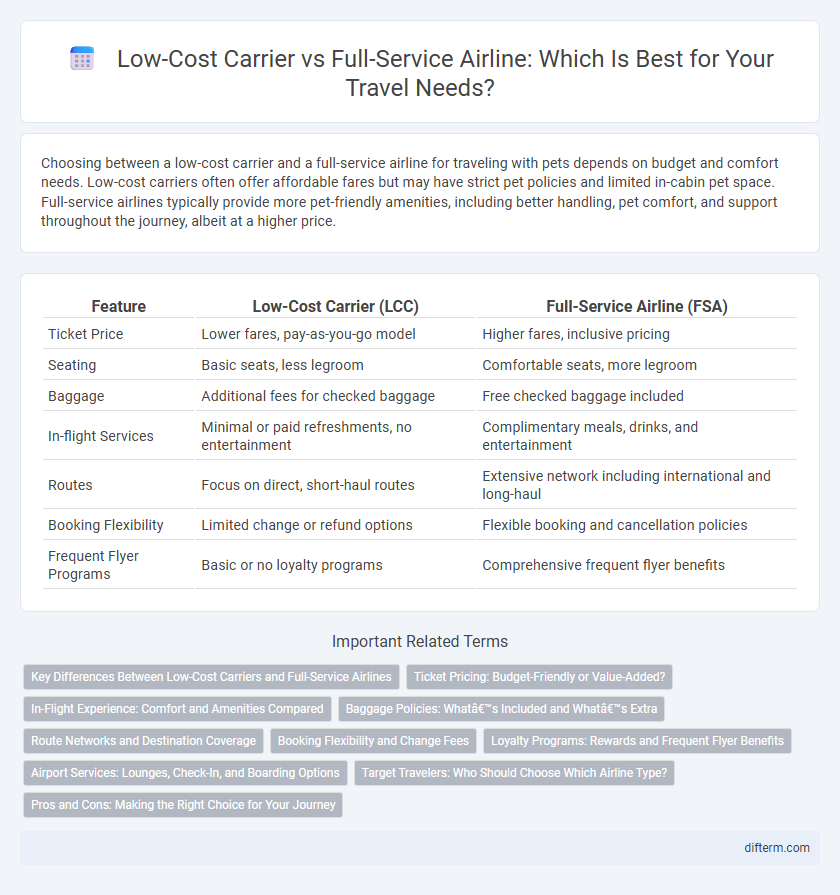Choosing between a low-cost carrier and a full-service airline for traveling with pets depends on budget and comfort needs. Low-cost carriers often offer affordable fares but may have strict pet policies and limited in-cabin pet space. Full-service airlines typically provide more pet-friendly amenities, including better handling, pet comfort, and support throughout the journey, albeit at a higher price.
Table of Comparison
| Feature | Low-Cost Carrier (LCC) | Full-Service Airline (FSA) |
|---|---|---|
| Ticket Price | Lower fares, pay-as-you-go model | Higher fares, inclusive pricing |
| Seating | Basic seats, less legroom | Comfortable seats, more legroom |
| Baggage | Additional fees for checked baggage | Free checked baggage included |
| In-flight Services | Minimal or paid refreshments, no entertainment | Complimentary meals, drinks, and entertainment |
| Routes | Focus on direct, short-haul routes | Extensive network including international and long-haul |
| Booking Flexibility | Limited change or refund options | Flexible booking and cancellation policies |
| Frequent Flyer Programs | Basic or no loyalty programs | Comprehensive frequent flyer benefits |
Key Differences Between Low-Cost Carriers and Full-Service Airlines
Low-cost carriers offer budget-friendly fares by minimizing onboard services, using single aircraft models, and operating point-to-point routes, while full-service airlines provide comprehensive amenities such as in-flight meals, entertainment, and multiple cabin classes. These budget airlines prioritize quick turnaround times and secondary airports to reduce costs, contrasting with full-service airlines that operate from major hubs with extensive network connectivity. Passenger experience varies significantly, with low-cost carriers focusing on affordability and efficiency, whereas full-service airlines emphasize comfort, loyalty programs, and flexible ticket options.
Ticket Pricing: Budget-Friendly or Value-Added?
Low-cost carriers typically offer budget-friendly ticket pricing by unbundling services and charging separately for extras like baggage and meals, appealing to cost-conscious travelers seeking basic transportation. Full-service airlines include additional amenities such as in-flight entertainment, meals, and baggage allowance in their fares, providing value-added services that justify higher prices. Choosing between them depends on prioritizing either upfront affordability or bundled comfort and convenience.
In-Flight Experience: Comfort and Amenities Compared
Low-cost carriers typically offer basic seating with limited legroom and minimal onboard services, focusing on affordability rather than comfort. Full-service airlines provide enhanced in-flight amenities such as wider seats, complimentary meals, inflight entertainment systems, and amenity kits to improve passenger comfort. Business and first-class cabins on full-service airlines feature spacious seating, lie-flat beds, and personalized service, creating a significantly more comfortable travel experience.
Baggage Policies: What’s Included and What’s Extra
Low-cost carriers often charge separate fees for checked luggage, carry-on bags, and even personal items, emphasizing a la carte pricing to keep ticket costs low. Full-service airlines typically include at least one checked bag and a carry-on allowance in the ticket price, offering more flexibility and convenience for passengers. Understanding baggage policies can significantly impact overall travel expenses, especially on long-haul or multi-segment flights.
Route Networks and Destination Coverage
Low-cost carriers typically operate point-to-point route networks targeting high-demand, short to medium-haul flights, enabling competitive pricing but limited destination coverage. Full-service airlines maintain extensive hub-and-spoke networks with broader destination reach, including international and long-haul routes, offering seamless connectivity and frequent transfer options. The contrast in route structures directly impacts travel flexibility, access to global markets, and passenger experience preferences.
Booking Flexibility and Change Fees
Low-cost carriers typically offer limited booking flexibility with strict change fees, often charging passengers for any itinerary modifications or cancellations. Full-service airlines provide greater booking flexibility, allowing travelers to change flights with lower or no fees, especially on premium fare classes. This difference significantly impacts travelers prioritizing adaptability in their travel plans and cost management.
Loyalty Programs: Rewards and Frequent Flyer Benefits
Low-cost carriers typically offer limited loyalty programs with basic rewards, focusing mainly on discounted fares and occasional upgrades, while full-service airlines provide comprehensive frequent flyer benefits including tiered membership levels, lounge access, priority boarding, and extensive partner airline networks. Full-service airline loyalty programs often accumulate points through multiple channels such as credit card spending and hotel stays, enhancing opportunity for richer rewards. Travelers seeking maximized reward redemption and premium benefits generally find full-service airline programs more advantageous despite higher ticket prices.
Airport Services: Lounges, Check-In, and Boarding Options
Low-cost carriers typically offer limited airport services, with minimal lounge access, basic check-in options often restricted to online or self-service kiosks, and standard boarding procedures. Full-service airlines provide a range of premium amenities including exclusive lounges, multiple check-in counters with dedicated staff, and priority boarding for business class and frequent flyers. These differences in airport services significantly impact passenger comfort and convenience during travel.
Target Travelers: Who Should Choose Which Airline Type?
Budget-conscious travelers seeking affordable fares and no-frills service should opt for low-cost carriers, which prioritize cost efficiency over extras. Business travelers or those valuing comfort, in-flight amenities, and flexible booking options are better served by full-service airlines offering premium seating, complimentary meals, and extensive route networks. Families and long-haul passengers benefit most from full-service airlines' added services, whereas solo tourists and short-haul travelers often find low-cost carriers more economical and convenient.
Pros and Cons: Making the Right Choice for Your Journey
Low-cost carriers offer budget-friendly fares by charging for extras like baggage and meals, ideal for cost-conscious travelers seeking basic transportation. Full-service airlines provide inclusive amenities such as in-flight meals, entertainment, and flexible ticket options, catering to passengers prioritizing comfort and convenience. Balancing price against services and route preferences helps determine the best choice for each journey.
low-cost carrier vs full-service airline Infographic

 difterm.com
difterm.com